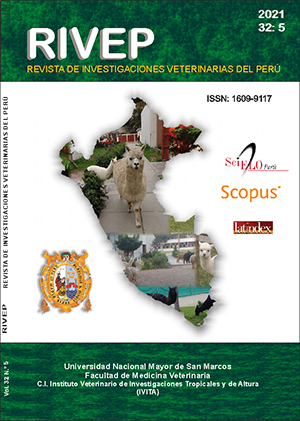Gastrointestinal nematodiasis in goats from Ica, Peru
DOI:
https://doi.org/10.15381/rivep.v32i5.21342Keywords:
goats, nematodes, Ica, Strongylus type eggAbstract
The aim of this study was to determine the prevalence of gastrointestinal nematodes in goats from four districts of the department of Ica, Peru, as well as to establish the association between the prevalence of these parasites with the variables age, sex and origin, determine the average parasite load and identify the genera and species of nematodes present. Stool samples were collected from 728 goats from the districts of Independencia, Humay, El Carmen and Chincha Baja between June and August 2017. For the identification and evaluation of the parasite load, the floatation techniques and modified McMaster were used. In addition, the techniques of Corticelli and modified Lai and Baermann were used for the culture and identification of the infective larvae (L3). A general prevalence of gastrointestinal nematodes of 67.6% (95% CI: 64.1-70.9) was obtained, being 92.5, 80.8, 59.1, 41.9% in the districts of Independencia, Humay, El Carmen and Chincha Baja, respectively. A significant association was found with all the variables under study (p<0.05). A prevalence of 63.7, 12.9 and 4.1% was determined for Strongylus (HTS), Skrjabinema spp and Trichuris spp eggs, respectively. The general geometric mean of the parasite load was HTS (259.4 hpg), Skrjabinema spp (70 hpg) and Trichuris spp (54.3 hpg), considered as low loads. The genera and species of infective lavas L3 cultured from HTS eggs were: Haemonchus spp (45%), Trichostrongylus spp (37%), Ostertagia spp (15%), Chabertia ovina (0.6%) and Cooperia spp (0.6%).
Downloads
Downloads
Published
Issue
Section
License
Copyright (c) 2021 María Cáceres V., Rosa Ysabel Pinedo V., Amanda Chávez V.

This work is licensed under a Creative Commons Attribution 4.0 International License.
AUTHORS RETAIN THEIR RIGHTS:
a. Authors retain their trade mark rights and patent, and also on any process or procedure described in the article.
b. Authors retain their right to share, copy, distribute, perform and publicly communicate their article (eg, to place their article in an institutional repository or publish it in a book), with an acknowledgment of its initial publication in the Revista de Investigaciones Veterinarias del Perú (RIVEP).
c. Authors retain theirs right to make a subsequent publication of their work, to use the article or any part thereof (eg a compilation of his papers, lecture notes, thesis, or a book), always indicating the source of publication (the originator of the work, journal, volume, number and date).



